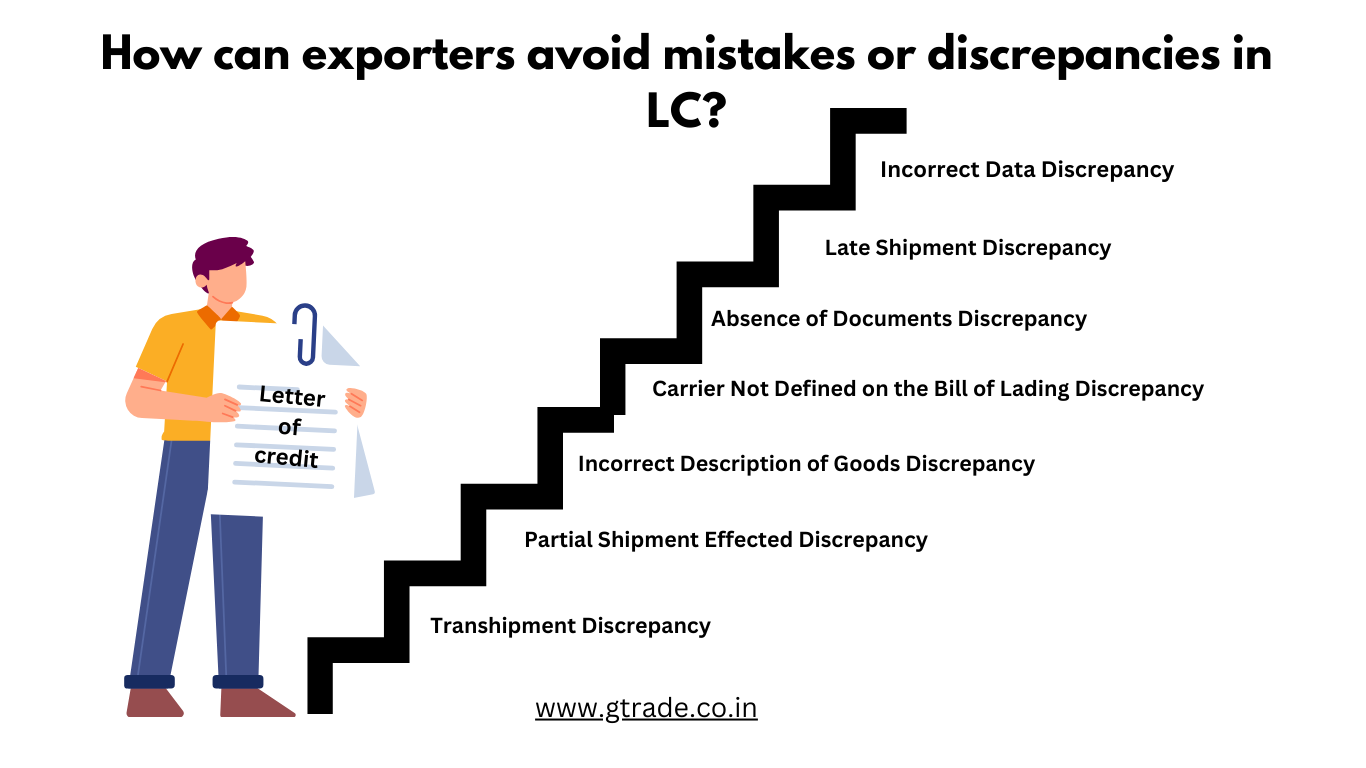In any international trade transaction, the issuing bank or the confirming bank must pay the credit amount to the beneficiary, when they determine that the presentation is complying. Under a discrepant presentation, the beneficiary can get the payment, only if the applicant accepts the discrepant documents. The most common mistakes exporters make is overseeing the discrepancy in LC & other documents, delaying the payment.

what is the meaning of discrepancy in LC?
Discrepancy can be defined as an error or defect, according to the issuing bank, in the presented documents compared with the documentary credit, the UCP 600 rules or other documents that have been presented under the same letter of credit.
If, the issuing bank or the confirming finds the document presentation non-complying with the LC terms and rules,or any of the above said rules, then the presentation becomes discrepant.
Discrepancies create problems especially for the exporters.Leaving the payment decision to the importers’ hands is a great deal of frustration for the exporters.
Once the documents are rejected, the issuing banks can only pay the credit amount, if and only if the importers accept the discrepancies.
The reasons why exporters make mistakes:
- lack of knowledge,
- could not understand the letter of credit mechanism and
- underestimating the risk factors associated with the letter of credit transaction.
Exporters should correct these Discrepancies in LC before shipment.
Inconsistency in Documents Discrepancy
UCP 600 states that “Data in a document, in context with the letter of credit must not conflict with, any other stipulated document or the credit.”
So if banks find inconsistency between documents, they raise a discrepancy.
Example: Container Number not in Accordance with the Bill of Lading Discrepancy
In a commercial letter of credit transaction the container number indicated on the packing list and bill of lading must not conflict with each other.
The mention of a wrong container number on the packing list, which is inconsistent with the container number indicated on the bill of lading, is a reason for a valid discrepancy and rejection of the presentation.
Incorrect Data Discrepancy
If information in any one of the document presented is not complying with the letter of credit terms and conditions banks raise a discrepancy, that at least one of the letter of credit condition is not indicated on the presented documents.
Example: Insurance Coverage is Insufficient Discrepancy
In a letter of credit transaction where an insurance policy or certificate is required, the amount of coverage must be determined in accordance with the letter of credit conditions and current L/C rules.
Letter of credit rules requires that minimum insurance cover must be at least 110% of the CIF or CIP invoice value of goods. if the insurance coverage is less than minimum insurance amount, the issuing bank raises a discrepancy, which is known as insurance coverage is insufficient.
Late Shipment Discrepancy
Goods shipped after the permitted shipment date or period.
If date of the transport document such as the bill of lading date corresponds to a later date than the latest date of shipment stipulated in the letter of credit, then banks raise the late shipment discrepancy.
The exporter should ship goods on board on or before the latest date of shipment mentioned in LC.
Late Presentation Discrepancy
Documents presented later than 21 days after shipment or after the number of dates stipulated in the letter of credit is late presntation discrepancy.
If the credit is silent on the latest date of presentation, then you have to present your letter of credit documents within 21 days after “the date of shipment”.
Sometimes the document presentation period can be shorter than 21 days, if mentioned in the letter of credit. Read your letter of credit very carefully in order to determine your presentation period.
Letter of Credit Expired Discrepancy
Documents presented after the letter of credit has expired.
Normally banks should not accept any documents that have been presented after the expiry date of the credit.
However, banks left the final decision to the applicants on this regard by evaluating the late presentation as a discrepancy.
Absence of Documents Discrepancy
Documents required by the letters credit is missing. Missing document discrepancy may also cover insufficient number of original documents presentation.
For example, the UCP 600 demands presentation of all original documents if that document states that it is issued more than one original.
If it is clear on the document that it is issued in two originals, then the beneficiary has to present both originals of the documents. If the beneficiary presents only one original instead of two originals, then the issuing bank raises absence of documents discrepancy.
Example: All original documents have not been presented discrepancy
Carrier Not Defined on the Bill of Lading Discrepancy
The name of the carrier on the bill of lading is not defined and bill of lading is not signed by the master, the carrier or an agent on behalf of the carrier.
Carrier Not Identified and Bill of Lading Not Signed As Per UCP 600 Discrepancy
UCP 600 Article 20 indicates that:
A bill of lading, however named, must appear to:
— indicate the name of the carrier and be signed by:
– the carrier or a named agent for or on behalf of the carrier, or
– the master or a named agent for or on behalf of the master.
Any signature by the carrier, master or agent must be identified as that of the carrier, master or agent.
Any signature by an agent must indicate whether the agent has signed for or on behalf of the carrier or for or on behalf of the master.
If banks could not locate the name of the carrier on the face of the bill of lading, then they mention this point as a discrepancy.
Incorrect Description of Goods Discrepancy
Description of goods indicated on the invoice and other trade documents differs from the description of goods stated in the credit.
According to the international standard banking practice, the description of the goods, services or performance shown on the invoice has to correspond with the description of the goods corresponding to that in the credit.
If banks determine that the description of the goods not corresponding to the letter of credit, they raise incorrect description of goods discrepancy.
Incorrect Endorsement / Absence of Endorsement Discrepancy
Bill of lading, insurance policy or draft (bill of exchange) not endorsed by the beneficiary of the credit.
The insurance document must be endorsed by the party to whose order claims are payable. If the letter of credit is silent as to the insured party and the insurance document does not name the Assured, it can be endorsed by the L/C Beneficiary as the lawful holder.
Partial Shipment Effected Despite L/C Terms Discrepancy
Exporters have to be very careful with the partial shipments
Partial shipment can be defined as shipping the goods not whole at once, but in more than one smaller shipments.
In order to understand, whether or not partial shipments are allowed under a documentary credit, you need to look at “Field 43P: Partial Shipments” within the swift message body.
- Field 43P: Partial Shipments: Allowed means that partial shipments are permitted
- Field 43P: Partial Shipments: Not Allowed means that partial shipments are not permitted.
If the issuing bank finds out that partial shipments have been effected, although the letter of credit prohibits partial shipments, then the issuing bank will raise partial shipments discrepancy.
Transhipment Discrepancy
A letter of credit has been issued in SWIFT format, subject to UCP 600, with the following details
Field 43T: Transhipment: Not Allowed
The beneficiary presents documents like bill of lading with transhipment on other vessel. The issuing bank identifies that transhipment is done, raises discrepancy on contrary to the letter of credit terms, because goods have been dispatched with two different vessels.
Bottom line: the exporter must be vigilant so that the LC terms and conditions are in complaince with all other documents of trade. if there is a discrepancy in documents, the LC can be amended by requesting the applicant and an amended Lc is issued by the issuing bank of the buyer or importer.

